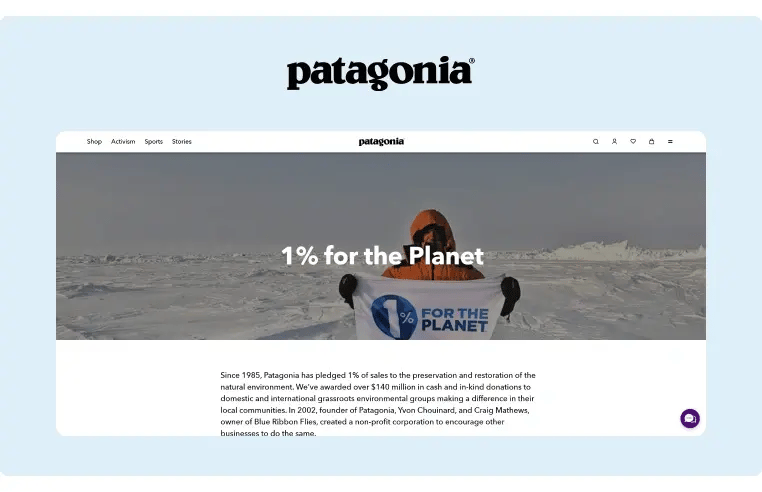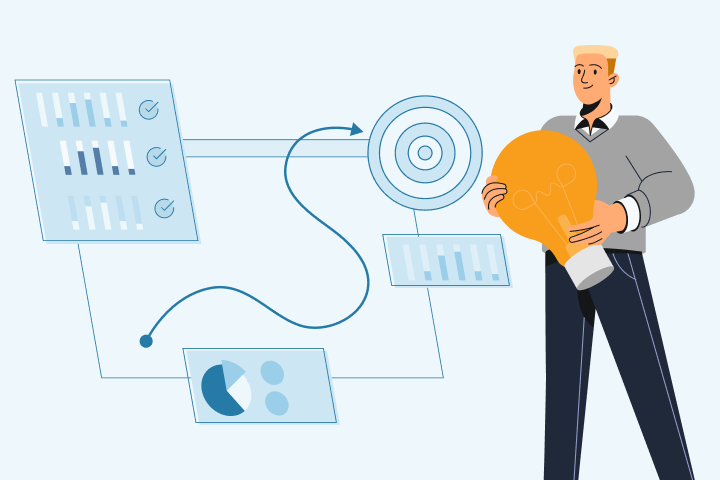Leveraging Your Brand Awareness: Marketing Strategy Tips
Brand awareness is all about being the first product or service that potential customers think of when making a purchase decision. It’s what helps a brand stand out in crowded marketplaces, making it recognizable and trusted. For that reason, it is both the first step in the marketing funnel as well as the foundation for all of your marketing efforts —- from SEO to social media.
But, how do you create this crucial foundation? How do you achieve the level of brand awareness that a tech giant like Apple enjoys? That's what we’ll explore in this article.
We’ll take you through the steps necessary to create a comprehensive marketing strategy that elevates your brand and makes a lasting impression on your audience.
What Is Brand Awareness?
Brand awareness is the extent to which consumers recognize and remember your brand. It's the first step in the marketing funnel, setting the stage for all future interactions with potential customers.
While brand awareness involves consumers identifying your brand's logo, colors, or tagline, brand recognition (or association) encompasses a deeper understanding of your brand's values, culture, and offerings. Essentially, brand recognition is when your brand identity and product become synonymous (e.g., when you need a tissue you ask for a Kleenex).
So, how does brand awareness fit into your marketing strategy?
It helps drive traffic, generate leads, and ultimately convert prospects into loyal customers. Brand awareness ensures consumers are already familiar with your brand, making it easier to capture their attention and encourage engagement.
Why Is Brand Awareness Important?
Brand awareness is crucial for several reasons, each one contributing to your brand's overall success and longevity.
Here’s why it matters:
1. Increases Marketing Impact
Strong brand awareness amplifies the effectiveness of your marketing campaigns, making it easier to connect with ideal consumers.
This familiarity means your marketing messages are more likely to be noticed and remembered, which leads to better campaign performance and higher ROI.
2. Builds Trust and Loyalty
A well-known brand is often perceived as more reliable and trustworthy. A study by Edelman, for instance, found that 88% of consumers find trust a key consideration when choosing to buy from a brand.
Source: Kantar
When your brand is recognized and trusted, customers are more likely to choose your products or services over competitors, even if it means paying a premium.
3. Enhances Brand Equity
Strong brand awareness contributes to brand equity, which is the value derived from consumer perception. For example, Apple’s brand equity allows it to charge higher prices for its products because consumers perceive its products as high-quality and innovative.
This perceived value translates into financial advantages, such as higher profit margins and greater market share.
4. Boosts Sales
Brands with high awareness are more likely to be considered for purchase by consumers, leading directly to increased sales. For example, Coca-Cola’s branding is so well-known and consistent that its logo and colors are recognized globally.
This high level of brand awareness leads to strong sales, as consumers are more likely to choose Coca-Cola over a lesser-known beverage.
5. Influences Consumer Purchase Decisions
Brand awareness influences purchasing behavior by creating a sense of familiarity and preference.
80% of consumers say brand familiarity (knowledge of the brand) makes them more likely to purchase from it on social media.
Key Elements of a Successful Brand Awareness Marketing Strategy
Building a strong brand awareness strategy involves multiple elements that work together to make your brand recognizable and trusted. They include:
1. Brand Positioning
Brand positioning is defining your brand’s unique value proposition and differentiating your brand from competitors.
Clear brand positioning helps you target the right audience and effectively communicate the unique benefits of your brand.
Tesla, for instance, positions itself as a leader in innovative electric vehicles (EV) and sustainable energy solutions. This positioning enables the company to attract environmentally-conscious consumers looking for cutting-edge EV technologies.

Source: Tesla
2. Clear Brand Messaging
Crafting consistent and compelling messages ensures your brand voice is clearly heard and recognized across all channels. Your messaging should reflect your brand's values, mission, and personality.
For example, Slack focuses its messaging on collaboration and productivity. Its marketing initiatives, such as the "Where Work Happens" messaging, consistently emphasize the importance of seamless team communication and efficient workflows.
These values have become synonymous with the brand and have helped it build a strong reputation as an essential tool for modern workplaces.

Source: Slack
3. Consistent Visual Identity
Maintaining visual consistency across all marketing channels helps reinforce brand recognition. This includes using the same logos, colors, fonts, and design elements in all your communications.
Take FedEx, for example. The company uses consistent color schemes, logo designs, and fonts across all of its shipping materials, advertisements, and digital platforms, making them instantly recognizable worldwide. Brand consistency also contributes to financial growth, with 33% of companies saying it contributed to their revenue by 20% or more.

Source: FedEx
4. A Multi-Channel Presence
Leveraging platforms such as social media, email, content marketing, and paid advertising maximizes your reach and ensures your brand is visible to a broader audience.
Red Bull does this by reaching its audience through a multi-channel approach that includes extreme sports events, social media, YouTube videos, and traditional advertising.
Marketers are experiencing significant results by investing in a multi-channel presence. It’s no wonder that the multichannel marketing industry is projected to grow to $28.6 billion by 2030.
5. Adaptability and Community Connection
Staying flexible and engaging with your community helps your brand remain relevant in times of changing market trends. To that end, responding to feedback, participating in conversations, and adapting strategies based on consumer preferences and market trends is crucial.
For example, Semrush actively engages with its users on social media to maintain a strong connection with its community.
Fostering community connection is especially vital since 43% of consumers browse social media to find goods and services, highlighting the importance of staying engaged and responsive.

Source: Semrush
Effective Tactics To Increase Brand Awareness
Building brand awareness requires a mix of creative and strategic tactics. Here are six effective methods to boost your brand’s visibility and resonance with your audience:
1. Engage Your Audience With Brand Storytelling
Using narratives to connect with your audience on an emotional level can make your brand more memorable.
Share your brand's story, values, and mission through compelling content. Craft stories that highlight the origins of your brand, the challenges you’ve overcome, and the impact you aim to make.
Outdoor and recreational clothing brand Patagonia, for instance, engages in storytelling focussed on environmental sustainability and the company’s commitment to conservation. This resonates deeply with eco-conscious consumers.

Source: Patagonia
2. Build Your Visual Asset Library
Creating and utilizing visual content, such as infographics, videos, and images, can radically enhance your brand's visibility and appeal. Visual assets are easily shareable and can capture attention quickly.
Develop a consistent visual style that aligns with your brand identity and use high-quality images and engaging graphics to tell your story.
For example, we have an infographic highlighting the performance of our employee advocacy customers on LinkedIn. Not only is it visual and eye-catching, but we can remix this asset for social media, email, and other use cases.
[Image]
Source: The Power of Employee Advocacy on LinkedIn (With Actual GaggleAMP Stats)
3. Maximize Your Social Media Presence and Engagement
Active engagement on social media platforms helps build a community around your brand.
Share valuable content, interact with followers, and participate in trending conversations to increase your brand's visibility. Regularly post content that is relevant to your audience and encourages interaction.
Use hashtags on X to join trending conversations and increase your content's reach.
For example, HubSpot’s X account is known for its witty and timely responses that engage directly with customers while participating in popular culture.

Source: HubSpot
4. Leverage Employee Advocacy
Encouraging employees to share company content on their personal social media accounts can expand your brand's reach and credibility. Employee advocacy humanizes your brand and showcases a positive work culture that consumers can relate to.
Create a structured employee advocacy program that provides employees with shareable content and incentives for participation.
5. Run Social Media Contests and Co-Ops
Social media contests or co-ops can boost visibility and engagement by encouraging user participation and sharing. Tailwind reports that Instagram accounts that run contests grow their followers 70% faster than those that don’t.
Use a unique hashtag or spin on your post to track entries and increase visibility. You can also run a contest in partnership with a complementary brand that resonates with yours to reach a wider audience.
Take the case of Tommy Walker’s recent report on the State of (Dis)Content Survey. Promoting the survey among audiences that are already engaged in content, and can likely relate to the sentiment of ‘discontent,’ their audience is more likely to convert on the survey than if Walker shared it only on his own.

Source: Rand Fishkin
6. Utilize Brand Awareness Ads
Using paid advertising to increase reach allows you to target specific audiences and achieve higher visibility.
Invest in display, social media, and video ads to promote your brand effectively. Utilize advanced targeting options to reach your ideal audience and A/B test different ad creatives to optimize performance.
Measuring Brand Awareness
Measuring brand awareness involves both quantitative and qualitative approaches.
Understanding these metrics can help you assess how well your brand is performing in terms of recognition and perception.
Quantitative Measures
Quantitative measures provide concrete data that can help you track the reach and impact of your brand awareness efforts. Commonly used quantitative measures are:
- Direct Traffic. Direct traffic refers to the number of visitors who type your website URL directly into their browser. This metric indicates the strength of your brand recall and recognition.
If your company launches a major marketing campaign such as a television ad or a large-scale digital campaign, monitor the changes in direct traffic to measure its effectiveness.
Pro Tip: Use Google Analytics to track direct traffic and identify trends over time. An increase in direct traffic often signifies growing brand awareness.
- Site Traffic Numbers. Monitoring overall website traffic and analyzing its sources can give insight into how different channels contribute to brand awareness.
For example, a spike in referral traffic after a guest post on a popular industry blog indicates successful brand awareness efforts through content marketing.
Pro Tip: Break down your traffic by source (organic, direct, referral, social, paid) to understand which channels are most effective in driving visitors to your site
- Social Engagement. Social engagement includes likes, shares, comments, and other interactions on your social media posts. High engagement levels often correlate with strong brand awareness.
If a particular type of post (for example, behind-the-scenes content) receives higher engagement, consider incorporating more of that type of content into your strategy to boost brand awareness.
Pro Tip: Use social media analytics tools to measure engagement rates and identify the types of content that resonate most with your audience.
Qualitative Measures
Qualitative measures provide deeper insights into public perception and the overall impact of your brand awareness efforts. These can include:
- Social Listening. Social listening involves monitoring online conversations about your brand to understand public perceptions. This can help you gauge sentiment and identify potential issues or opportunities.
For example, If you notice a surge in positive mentions following a product launch, it indicates successful brand awareness and positive reception.
Pro Tip: Use social listening tools to track mentions of your brand across social media platforms, forums, and blogs.
- Brand Awareness Surveys. Conducting surveys helps you directly gauge how well your audience recognizes and recalls your brand. Surveys can reveal insights into brand perception, loyalty, and areas for improvement.
To measure top-of-mind awareness, ask questions like, “When you think of [your industry], which brands come to mind first?” Follow up with questions about specific attributes associated with your brand to gauge perception.
Pro Tip: Include questions about brand recall, recognition, and perception in your surveys. Use a mix of open-ended and multiple-choice questions to gather comprehensive insights.
Examples of Successful Brand Awareness Campaigns
Examining successful brand awareness campaigns can provide valuable insights and inspiration for your own strategies.
Here are three notable B2B case studies that highlight effective brand awareness efforts.
1. Canva’s ‘What Will You Design Today?’ Campaign
In 2022, Canva launched its ‘What Will You Design Today?’ campaign to inspire creativity and showcase the versatility of its design platform. This campaign aimed to highlight how Canva empowers individuals and teams worldwide to achieve their goals through creative collaboration.

Source: Canva
Here’s why it was so successful:
- Showcased Real Stories. Canva featured inspiring stories from its global community, including professionals, students, and large teams. The campaign showcased how these users leveraged Canva to launch side hustles, deliver winning sales presentations, and champion change.
- Used a Multi-Channel Approach. The campaign rolled out across national TV ads, outdoor billboards, YouTube, social media, and audio channels in the US, with expansions planned for Canada, the UK, and Australia. This wide-reaching approach ensured optimal brand visibility.
- Focused on Community Engagement. Canva actively involved its community by calling for stories and featuring real users in the campaign. This not only celebrated the community but also highlighted the diverse ways Canva is used.
Plus, many marketers do not have the luxury of an in-house designer; they are the designer. They can resonate and connect with the sentiment of the campaign.
2. Pinterest’s ‘The P Is for Performance’ Campaign
In February 2024, Pinterest launched ‘The P Is for Performance,’ an international, high-concept campaign to promote a full suite of products for advertisers. The cinematic and high-energy approach of the campaign aimed to capture the attention of performance marketers.

Source: Pinterest
Here’s why it was so successful:
- Featured High-Concept Mini-Movies. The campaign featured action-packed mini-movies to demonstrate how ads on Pinterest drive results, not just brand awareness. These films were inspired by iconic action movies and aimed to break the conventions of B2B marketing with elevated style and unexpected elements.
- Used a Cinematic Approach. Pinterest worked with Tim Godsall, an internationally acclaimed commercial director, to produce a series of mini-films featuring two heroines dodging dangers while discussing the benefits of Pinterest’s performance-based ad platform.
- Focused on Digital. The campaign ran on paid social, programmatic, and trade publication channels in the U.S., UK, and Australia, with plans to enter additional markets later that year.
3. Shopify’s ‘Let’s Make You a Business’ Campaign
Shopify’s ‘Let’s Make You A Business’ campaign was designed to empower entrepreneurs and small business owners to turn their ideas into thriving online businesses. The campaign focused on showcasing Shopify’s ease of use and comprehensive features.

Source: Shopify
Here’s why it was so successful:
-
Featured Inspirational Content. Shopify created content, including videos and blog posts, that featured success stories of small businesses using the platform to grow their online presence.
-
Offered Free Trials and Demos. It offered extended free trials and live demos to encourage new users to try the platform and experience its benefits firsthand.
-
Partnered With Influencers and Mentors. Shopify partnered and collaborated with influencers and business mentors to provide additional support and credibility to the campaign.
Boost Your Brand Awareness Strategy With GaggleAMP
Enhancing your brand's visibility can be as simple as sharing your brand’s story, creating engaging visual content, and staying active on social media.
Encouraging your employees to advocate for your brand will further amplify your efforts.
If you’ve been thinking about building an employee advocacy program, there’s no better time to start than now. GaggleAMP can help you maximize your employee advocacy efforts, making it easy for your team to share your content and expand your reach.
Schedule a demo today and watch your brand awareness grow!











